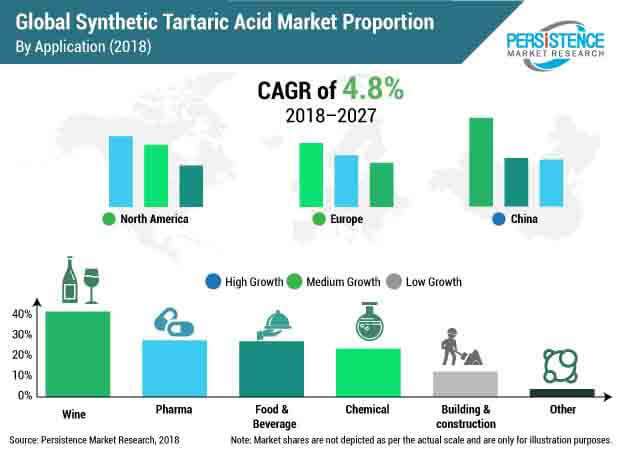![]() 204 Users Online
204 Users Online
Synthetic Tartaric Acid Market Segmented By L (+)- Tartaric Acid, D (-)- Tartaric Acid, DL Tartaric Acid in Wine, Food and Beverage, Pharmaceuticals, Chemicals, Building and Construction
Tartaric acid, also known as 2,3-Dihydroxysuccinic acid, is a white crystalline organic compound produced from natural resources naturally or synthetically. Naturally, tartaric acid exists in grapes, tamarinds and bananas, among other citric fruits. However, synthetic tartaric acid can also be produced chemically from maleic anhydrates.
Mainly, China dominates the synthetic tartaric acid market in terms of production. There are three kind of stereoisomers of synthetic tartaric acid: L (+) synthetic tartaric acid, D (-) synthetic tartaric acid and meso synthetic tartaric acid. Racemic synthetic tartaric acid i.e. DL-tartaric acid is a synthetically produced mixture of 50% L (+) and 50% D (-) tartaric acid. Synthetic tartaric acid is widely used as an antioxidant, acidifier, stabilizer, flavour enhancer and a sequestering agent.
In the Food & Beverage Industry, synthetic tartaric Acid is used as an acidifier, code no. E334, mostly in the wine industry to regulate pH. Synthetic tartaric acid is also used as a taste enhancer in candies, sweets, jams, jellies, ice creams and fruit nectars, among other products. Moreover, it is also used as an antioxidant and emulsifier in the bakery industry.
The global Synthetic tartaric acid market is estimated to reach a value of US$ 531.4 Mn by 2018 end and is projected to reach US$ 804.7 Mn by the end of 2027. The Synthetic tartaric acid market is estimated to expand at a CAGR of 4.8% during the forecast period. The global Synthetic tartaric acid market is expected to create incremental $ opportunity worth US$ 273.3 Mn over the period of 2019-2027.
Globally, the food & beverage (F & B) industry is witnessing phenomenal growth and is expected to continue to grow during the forecast period. This is mainly due to increasing population, changing dietary habits, growing per capita spending, technological advancements in F & B processing and growing shelf life of food products, among others.
Since the past couple of years, the consumption rate of wine has been surging globally and is expected to steadily grow further during the forecast period. During the production of wine, synthetic tartaric acid is used as an acidity regulator and helps to manage pH level of wine.
Production of wine to cater to the rising demand across the globe and demand for additives, such as flavor enhancers and acid regulators, among other additives, are expected to increase over the forecast period. Along with this, increasing demand for synthetic tartaric acid as an emulsifier in the bakery industry will also provide impetus to the growth of the market.
In drug formulations, synthetic tartaric acid is used as an excipient for the preparation of effervescent tablets, powder and granulates. Furthermore, efforts are being made by governments and regulatory agencies in developed nations, such as the U.S. and the U.K., to streamline the approval process for excipients, which is also expected to push the growth of the pharmaceutical excipients market, which in turn, is expected to drive the synthetic tartaric acid market during the forecast period.
Moreover, within the cement industry, especially in gypsum and plaster applications, synthetic tartaric acid used as used as a retardant to improve the handling of these products. Thus, increasing number of housing & infrastructure projects in developed and developing industries will help to drive the synthetic tartaric acid market.

China, the largest market for synthetic tartaric acid, accounts for nearly 28% of the global synthetic tartaric acid consumption owing to the significant growth in wine production and expanding construction and pharmaceutical industries in the country.
China is estimated to maintain its dominance in the global synthetic tartaric acid market during the forecast period. Moreover, India and China have witnessed healthy growth in construction and pharmaceutical industries in the recent past. This is anticipated to create opportunities for key manufacturers in the synthetic tartaric acid market.
In developed countries, especially in North America and Europe, consumers are well-aware of the nutritional importance of fruits and beverages. However, stringent regulations implemented by European and Canadian Governments regarding the use of synthetic tartaric acid in wine production, mentioned under Commission Regulation (EC) No 606/2009, Appendix 2 and Canadian General Standards Board Committee on an Organic Agriculture’s CAN/CGSB-32.311 (includes synthetic tartaric acid), will hamper the demand for synthetic tartaric acid in these regions.
However, increasing demand for synthetic tartaric acid from non-food applications in Europe and North America will help to drive the synthetic tartaric acid market during the forecast period. Latin and MEA synthetic tartaric acid markets are expected to register steady growth over the forecast period
Some of the players reported in this study on the global synthetic tartaric acid market are Ninghai Organic Chemical factory, Yantai Taroke Bio-engineering Co.Ltd. Australia Tartaric Product Pty Ltd., Industria Chimica Valenzana ICV Spa, PAHI SL, Hangzhou Regin Bio-Tech Co.Ltd, Hangzhou Linan Jinlog Chemicals Co.Ltd, Hangzhou Ruijing Biotechnology Co.Ltd, Changmao Biochemcials Engineering Co.Ltd and Derivados Vinicos SA, among others.
| Attribute | Details |
|---|---|
| Product Type |
|
| Application |
|
| Region |
|